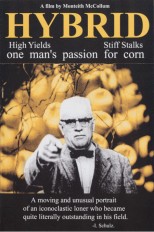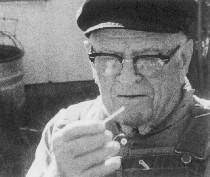|
Hybrid
|
| |
 |
Documentary. USA, 2000. Rated PG-13.
90 minutes.
Cast:
Milford Beeghly
Music: Monteith McCollum
Cinematographer: Monteith McCollum
Editor: Adriana Gerstein
Producers: Monteith McCollum
Director: Monteith McCollum
LINKS
|
 ome
documentaries have such absorbing storylines that they're almost impossible
to screw up (Hoop
Dreams and Startup.com are two examples). The best thing a filmmaker
can do in those cases is get out of the way and let the story tell itself. Other
subjects require directorial goosing; Hybrid, a documentary about the
man who pioneered the genetic engineering of corn, is an ideal candidate. How
does one make a watchable movie about corn? The answer: corn porn.
ome
documentaries have such absorbing storylines that they're almost impossible
to screw up (Hoop
Dreams and Startup.com are two examples). The best thing a filmmaker
can do in those cases is get out of the way and let the story tell itself. Other
subjects require directorial goosing; Hybrid, a documentary about the
man who pioneered the genetic engineering of corn, is an ideal candidate. How
does one make a watchable movie about corn? The answer: corn porn.
I kid you not. Director Monteith McCollum pulls out all the stops, including
a stop-motion animated scene of copulating corncobs sure to arouse vegetable
fetishists everywhere. Corn, it is revealed, is a highly sexual plant, whose
reproductive organs are prominent and tasty. Those kernels of corn that you
are probably munching right now are actually the ripe ovaries of the plant.
Mmmm…ovaries!
Though there is much talk of stiff stalks and easy husking, McCollum isn't
primarily concerned with titillating his audience. In fact, corn and hybridization
are only pretexts for the real subject of the film: McCollum's centenarian grandfather
Milford Beeghly, a name that sounds charmingly like one of W.C. Fields' pseudonyms.
By introducing inbreeding, Beeghly innovated corn crossbreeding at a time when
corn incest was frowned upon. Hybrid catches up with him entering into
a second marriage at the ripe age of 94, and spends time with him over the next
six years, picking his mind in the cornfield and tending at his bedside through
a bout with pneumonia. The film became oddly affecting when I realized that
it was the story of a grandson trying to relate to and understand his eccentric
grandfather. Hybrid is a document that will outlive Milford Beeghly, and it's touching
to hear McCollum ask his granddad to show the world how he uses a toothpick,
and to see Beeghly captured on film, singing in a grain silo.
Hybrid is a document that will outlive Milford Beeghly, and it's touching
to hear McCollum ask his granddad to show the world how he uses a toothpick,
and to see Beeghly captured on film, singing in a grain silo.
Earlier interviews in the film lend these scenes resonance. Beeghly's son and
daughter describe him over and over as a remote, uncommunicative man who was
more interested in corn than his children. It becomes apparent that Beeghly's
kids never sought to understand what their father was doing as much as he never
sought to explain his work to them. By the time McCollum breaks the ice, Beeghly
has thawed from sixty summers of corn crops, and speaks contemplatively about
man's relationship with nature, and his own relationship with his family. The
budding connection between filmmaker/grandson and subject/grandfather is ample
reward for an occasionally sluggish viewing experience.
McCollum's relaxed, unhurried pace is of a piece with the country life it depicts,
but there are stretches of the film, particularly in the middle third, when
it begins to feel suspiciously like padding. A sequence of barnyard animals
drinking milk lasts for several minutes and bears no relation to anything that
precedes or follows it. Much of the interview footage is repetitive. McCollum
seems to be going after a Robert Flaherty-like style of poetic naturalism--an
ode to the American Farmer--but the images aren't as resonant as Flaherty's.
At least he's trying; few documentaries could be described as cinematic. Other
than Errol Morris, most documentarians do little to embellish the reality they
record. I suppose it could be seen as misrepresentation to adjust the lighting
or frame shots precisely, but this method of editorializing is less extensive
than the editing process that determines what we do or do not see in the first
place. In all movies, even documentaries, the world is seen through somebody
else's glasses. The distortion of reality is natural, a prescriptive lens that
enables clarity.
Hybrid is shot in 16mm black and white and generously employs time-lapse
photography, creative camera movements, archival footage, and different lenses
to compile a varied mix of looks for the film. The time-lapse shots are obviously
helpful in showing plant growth, but also unexpectedly effective in a scene
at the hospital, where Beeghly lies in bed, stricken with pneumonia. As he is
tossed and turned for days by hospital staff, or weeks, the shot contrasts specifically
with the previous time-lapse shots of seeds bursting and life emerging. The
winding down of life, and the last heartfelt attempt to uncover and understand
it, accord the film and its subject a quiet nobility.
Review
© September 2002 by AboutFilm.Com and the author.
Images © 2002 Indican Pictures. All Rights Reserved.

 Hybrid is a document that will outlive Milford Beeghly, and it's touching
to hear McCollum ask his granddad to show the world how he uses a toothpick,
and to see Beeghly captured on film, singing in a grain silo.
Hybrid is a document that will outlive Milford Beeghly, and it's touching
to hear McCollum ask his granddad to show the world how he uses a toothpick,
and to see Beeghly captured on film, singing in a grain silo.
